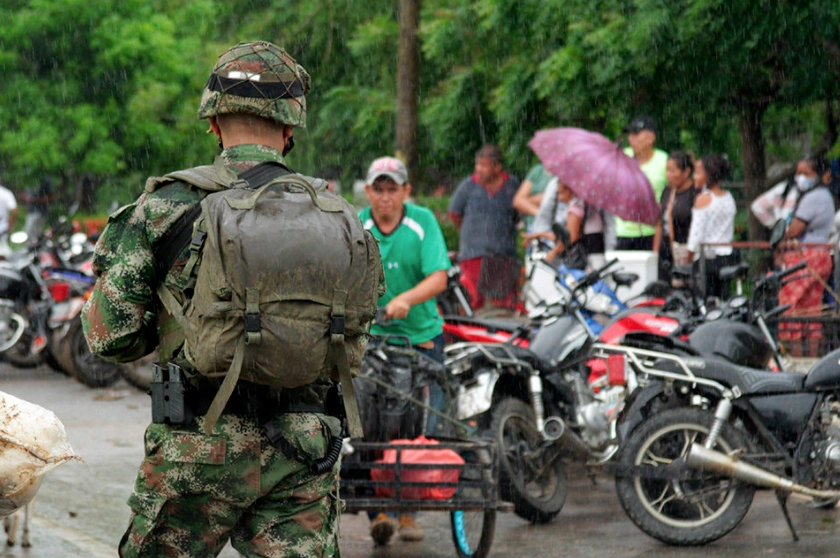During the visit of Colombian President Iván Duque and the country’s military leadership to Arauca on January 16, within the framework of a security council, 18.4 kilometers away, members of the National Liberation Army (ELN) walked through the streets of La Esmeralda, in the municipality of Arauquita, terrorizing the population. This is another chapter in a series of similar events that have taken place for at least 30 years in the area. The border between Colombia and Venezuela has been inhabited by illegal groups such as the ELN, the Popular Liberation Army (EPL), the defunct FARC (which in the 21st century began to migrate to Venezuela), and hybrid criminal actors that fight each other for the right to receive illegal rents.
The area shared by both countries has witnessed the transformation and mutation of the armed conflict along with the precarious state presence of both Caracas and Bogota. While violence and insecurity in the area has persisted for three decades, the situation has degraded over the last year to the point where the actors involved are increasingly diffuse.
This border zone is a geographic micro-complex of great strategic importance, which has subsequently fostered the development of a far-reaching binational criminal network. On the Venezuelan side there are the Alto Apure territories of Guasdualito, El Amparo, Puerto Paez, and Elorza. On the Colombian side there are the municipalities of Arauquita, Saravena, Fortul, and Tame, in Arauca; and Cubará in Boyacá. In this area, in addition to the absence of formal institutions in both countries, criminals are the ones who exercise control and govern while competing for drug trafficking routes, and to dominate human and arms trafficking.
Between 2016 and 2022, in Arauca and Apure, ELN formations and the Tenth Martin Villa Front group have coexisted as FARC dissenters. Both compete for illicit markets, carrying out armed actions that resulted in more than 30 deaths and the displacement of 400 people at the beginning of 2022.
There are several reasons for the current problems. On the one hand, the Venezuelan narrative has maintained that there is an ongoing destabilization campaign from Colombia that consists of sending violent actors to commit criminal acts in its territory. In fact, over the last 14 months there has been fighting between the Venezuelan armed forces and Colombian irregular groups. This has led to the severe displacement of families and has exacerbated the humanitarian crisis in the region.
On the other hand, the Colombian version of the crisis in the area is that Bogotá has launched military operations against dissidents belonging to the former FARC. This version is shared by the 2020 Human Rights Watch report on the increase of violence in Apure and Arauca.
However, the aggravating factor here is that there is an actor that has been little mentioned in the media and has been given little importance in the analysis of the issue. This is the Venezuelan guerrilla group “Fuerzas Patrióticas de Liberación Nacional” which, according to several international organizations, has a close relationship with the local Venezuelan authorities.
Regardless of the armed actors operating there, the civilian population has been the victim and the center of gravity of the situation. In this sense, the explanations can be further deepened by chaining together the series of phenomena and issues of the crisis. Security in Colombia is not at its best. The country has entered a spiral of insecurity and violence of different natures due to the proliferation of various armed groups that are seeking to control territories for illegal rents.
In fact, the low implementation of the peace agreement signed in 2016 (30%) is of serious concern in the country due to the murder of social and environmental leaders, and the forced displacement and murder of former combatants. This phenomenon and the impossibility of the Colombian State to effectively govern the whole territory could lead to a third cycle of violence where Arauca plays an important role.
In effect, Colombian security authorities have tried to regain control in the area but have found that neither the military nor the police are able to do so. One of the explanations for the causes of the violence between Arauca and Apure has to do with the Duque administration’s misguided notion of militarized security.
An excess of military personnel does not imply greater security. In addition, there is a disconnect between the decision-makers’ idea of security and the day-to-day reality of territorial violence. Finally, there is a permissiveness from Venezuela that allows the ELN to act as binational guerrillas. Meanwhile, the foreign ministries of both countries ignore the importance of having non-ideological relations for the good of the territories and communities in the region.
As long as Bogotá and Caracas do not reestablish diplomatic relations, the irregular armed groups will have more management capacity in Arauca and Apure than the state institutions. Neither the Casa de Nariño nor Miraflores possess the ability to govern in the area, the criminals do.
Translated from Spanish by Alek Langford











